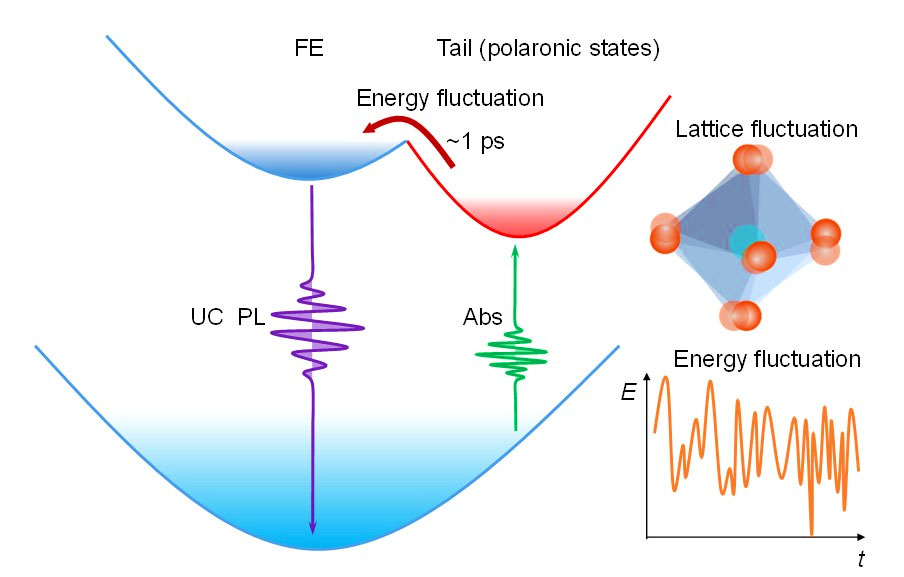| Oct 09, 2023 |
Researchers reveal mechanism of efficient upconversion in two-dimensional perovskite
(Nanowerk News) Recently, a research team led by Prof. LIU Xinfeng from the National Center for Nanoscience and Technology (NCNST) of the Chinese Academy of Sciences (CAS) reported the efficient phonon-assisted upconversion luminescence in a quasi-two-dimensional perovskite system.
|
Key Takeaways
|
|
Researchers unveiled efficient phonon-assisted upconversion luminescence in a quasi-two-dimensional perovskite system.
The team identified a phonon action time of approximately 1.2 ps and an anti-Stokes shift energy over 200 meV, attributing high upconversion energy gains to strong lattice fluctuations.
The study highlights the role of lattice deformation and dynamic polarons in efficient upconversion in quasi-2D perovskites, offering new insights into electron-phonon coupling and potential design strategies for high-efficiency upconversion.
|
The Research
|
|
The study was published in Science Advances ("Uncovering the mechanisms of efficient upconversion in two-dimensional perovskites with anti-Stokes shift up to 220 meV").
|
 |
| Schematics of the energy diagram and dynamics of upconversion in perovskites. (Image: LIU Xinfeng et. al)
|
|
Photon upconversion is a physical process where the emitted photon energy is greater than the absorbed photon energy. Upconversion can be achieved through various methods, including multi-photon nonlinear absorption, triplet-triplet annihilation in organic molecules, energy transfer in rare-earth metal doped materials, and thermal-assisted photon absorption. Among them, phonon-assisted upconversion is the theoretical and experimental basis for solid-state laser cooling.
|
|
However, how phonons are involved in the anti-Stokes upconversion process and improve upconversion efficiency and energy gain has been a key scientific question in this field for a long time.
|
|
In their previous study, LIU's group and their collaborators have realized the self-trapped state emission by constructing nanoscale superlattice structures to enhance the electron-phonon strong coupling, and proposed that "organic"-"inorganic" soft lattice structures are expected to be a platform for the study of electron-phonon strong coupling effects.
|
|
On this basis, in this study, the researchers achieved efficient phonon-assisted upconversion luminescence in a quasi-two-dimensional perovskite system of organic-inorganic soft lattice by combining soft lattice with low dimensionality.
|
|
They found a phonon action time of about 1.2 ps and an anti-Stokes shift energy of more than 200 meV. Moreover, the team proposed to attribute the origin of high upconversion energy gains to strong lattice fluctuations, in contrast to the phonon absorption pictures in classical upconversion theory.
|
|
Moreover, the research team carried out microscopic transient absorption measurements and density functional theory calculations to explain efficient upconversion ultrafast process. The motion of the organic cation at ps timescales causes the entire lattice to deform, resulting in rapid changes in the phonon-renormalized electron/exciton energy. This provides the low-energy excitons with sufficient energy to reach quasi-equilibrium states (free exciton) where they can recombine radiatively.
|
|
Hence, the efficient upconversion in quasi-2D perovskites is not directly attributed to the absorption of specific phonon modes in the perturbative theory. Instead, it arises from the alteration of electronic energy linked to the pronounced thermal-driven deformation of the entire lattice or, alternatively, the formation of dynamic polarons. The band energy fluctuation, reaching approximately ±180 meV at room temperature due to the strong non-perturbative interaction with lattice deformation, allows for a remarkable upconversion energy gain that cannot be attained in traditional semiconductors.
|
|
"Our study clarifies time scale of the participation of chalcogenide phonons in upconversion, deepens understanding of the electron-phonon coupling mechanism, and provides a new perspective for the design of high-efficiency upconversion," said Prof. LIU.
|

